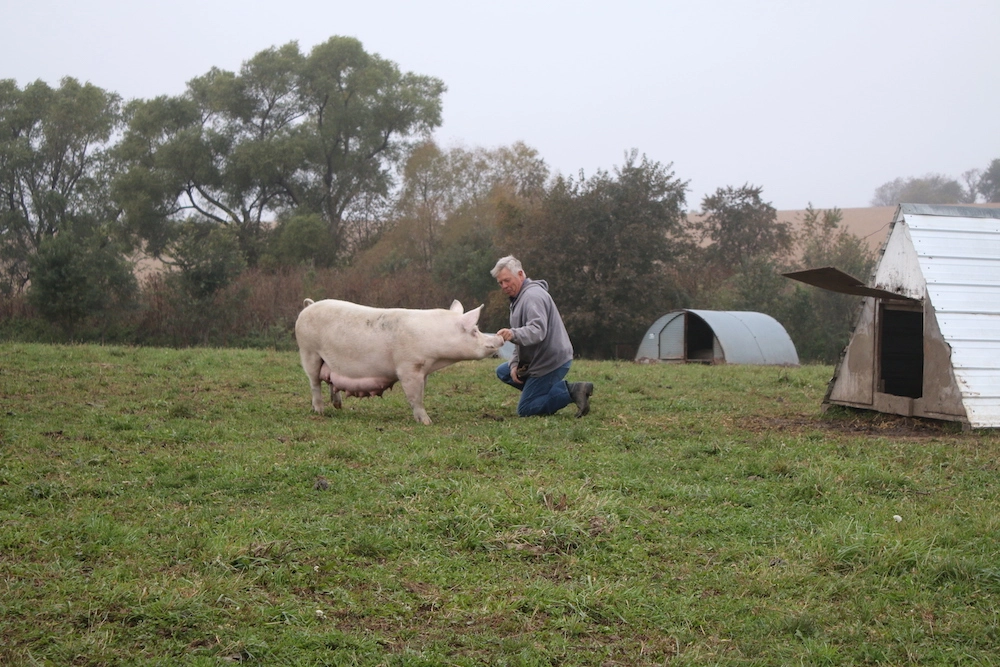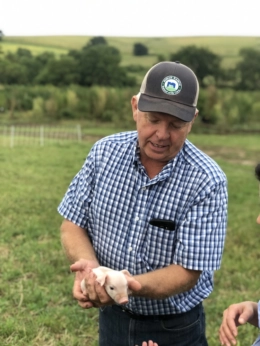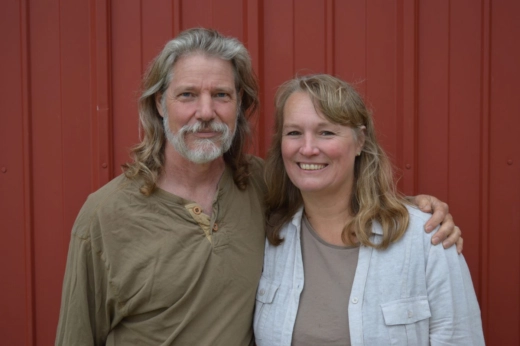On the Ground With the Farmers Producing Antibiotic-Free Meat
As the sales of antibiotics for use in livestock increase, these farmers say they have a better way.
On the Ground With the Farmers Producing Antibiotic-Free Meat
As the sales of antibiotics for use in livestock increase, these farmers say they have a better way.

Ron Mardesen does not use antibiotics on his hog farm in Elliot, Iowa.courtesy of Ron Mardesen.
Nearly four decades ago, Ron Mardesen and his wife Denise stopped using antibiotics on their hog farm, A-Frame Acres, in Elliot, Iowa. He decided there was a better way to raise his animals, one that wouldn’t require the need for routine antibiotics. After prioritizing clean feed, fresh air, comfortable bedding and plenty of space, he says his pigs began to thrive. In 2002, Mardesen started selling his pork to Niman Ranch, a network of independent family farmers that raise livestock without antibiotics or added hormones.
As the owner of a multi-generational farm, Mardesen has seen industrial agriculture and factory farming take increasing control over meat production in the last few decades. With that has come the extreme overuse of antibiotics in livestock farming.
“You know, we want to produce more pounds of pork, more pounds of beef, more pounds of chicken on smaller and smaller resources. The best way they have come up with to continue with this efficiency push is to pound antibiotics,” says Mardesen. “I have never been comfortable taking an animal as intelligent as a pig and cramming them into a concrete box for the sake of efficiency.”
A recent report released by the US Food and Drug Administration (FDA) found that antibiotic sales for meat production increased by 4 percent from 2021 to 2022, with pigs and cattle accounting for the majority of sales. Antibiotic sales for animal use peaked in 2015, after which the FDA banned the use of antibiotics for animal growth, leading to a major decline in antibiotic sales the following year. But from 2017 onwards, antibiotic sales for livestock farming have steadily risen each year, increasing 12 percent from 2017 to 2022.
“I have never been comfortable taking an animal as intelligent as a pig and cramming them into a concrete box for the sake of efficiency.”
About 70 percent of medically important antibiotics in the US are sold for animals, not humans. The more an antibiotic is used, the more both animals and humans develop resistance to them, which significantly lowers the effectiveness of the intervention, says Steve Roach, food program director at Food Animal Concerns Trust (FACT), an organization that advocates for humane farming.
While antibiotics were originally used to treat sick animals, in the 1940s, farmers discovered regular antibiotic use could make animals grow faster in less time and with fewer resources.
Although the US banned the use of antibiotics for growth, they are still used for disease prevention and disease control. If one animal gets sick, the entire group is often treated because they live in such close proximity to one another.
Nearly a third of medically important antibiotics have no duration limit, meaning a farmer can use those antibiotics in feed for as long as they want to prevent disease. Roach says this allows farmers to keep animals in poor living conditions that are more likely to get them sick.

Antibiotic use is particularly common on factory farms, where certain practices lead to disease in animals. Cattle are often fed a corn or soy diet instead of grass, which can lead to illness. Baby pigs are weaned off their mother’s milk and fed solid foods before they’re ready, causing diarrhea.
“Having animals close together in crowded conditions, it saves you money, but also disease can easily spread,” says Roach. “You give them a diet that causes problems, so you basically just feed them antibiotics continuously.”
Lynn Utesch, a cattle farmer in Kewaunee County, Wisconsin—a region often referred to as CAFO alley for its high concentration of factory farms—discovered early on that, with the right methods, he doesn’t need antibiotics to raise his cattle. He and his wife Nancy own a 150-acre grass-fed beef farm and use a rotational grazing method. Every two days, they move their cows to a new pasture and the animals have plenty of space from one another. In his 30 years farming, Utesch has never had to use antibiotics on his cattle, not even for treatment.
“If you allow the animal to eat its natural diet, if you allow it to live the way that nature intended out in the open air and where it cannot be confined tightly to the other cows, then you don’t have any need for antibiotics because those animals are completely healthy,” says Utesch.

When the Utesches started farming, their customers expressed a preference for antibiotic-free, grass-fed beef. It was hard to find that elsewhere at the time. These days, it’s what many consumers look for. A 2021 poll found that “antibiotic-free” labels are important to two-thirds of Americans when buying meat.
Despite this priority, labeling is far from straightforward. From “antibiotic-free” to “no antibiotics routinely used” to “antibiotics may be used,” there are plenty of ambiguities within labeling and there is little room for nuance, says Roach. Antibiotics were designed to treat sick animals, but the overuse and lack of transparency has led to “an all-or-nothing mindset” and negated their original intent, he says.
FACT supports antibiotic use for animal treatment, but only if it is approached with transparency and communication between the farmer and the certifier. The Antibiotic Resistance Action Center at George Washington University is developing a “certified responsible antibiotic use” label, which would allow antibiotics for treatment but not for prevention.
“When you do use antibiotics for treatment, you need to report that to the certifier and let them know. And so we kind of prefer that label, but it’s harder to communicate that to the consumer,” says Roach.
Unlike Utesch, Mardesen of A-Frame Acres does use antibiotics to treat a pig if it falls ill, but he uses a strict documentation process. He has to clearly identify the animal, what type of antibiotic was administered, the outcome of the treatment and where the animal was marketed. He cannot sell that pork to Niman Ranch, which has a strict “no-antibiotics ever” policy.
“If I do get an animal that does get sick, because I don’t routinely always throw antibiotics at these animals, when I have to treat an animal, the antibiotics that are available to use work a lot better on the farm,” says Mardesen.
Limiting antibiotic use will likely require stricter regulation from the FDA and more transparency in labeling. The USDA is considering implementing higher standards for meat to be labeled antibiotic free. But both Mardesen and Utesch say it starts with changing practices that benefit the animals so antibiotics aren’t needed for prevention or control. If there wasn’t such a focus on yield and production in the food system, fewer animals would be crammed into tight spaces and fed poor diets, says Utesch.
As a consumer, Utesch says the best thing you can do is educate yourself and learn where your food comes from. Look for organic and grass-fed meat, understand the different labels and, most of all, build a relationship with your local farmer.
“Find a farmer, and not only just pick up the product the farmer has, but have a relationship where you say, ‘What does rotational grazing mean? Or outdoor access? What does that mean to you?’ Have a conversation about how an animal is actually raised and handled,” says Nancy Utesch.
Follow us
This work is licensed under a Creative Commons Attribution-NoDerivatives 4.0 International License.
Want to republish a Modern Farmer story?
We are happy for Modern Farmer stories to be shared, and encourage you to republish our articles for your audience. When doing so, we ask that you follow these guidelines:
Please credit us and our writers
For the author byline, please use “Author Name, Modern Farmer.” At the top of our stories, if on the web, please include this text and link: “This story was originally published by Modern Farmer.”
Please make sure to include a link back to either our home page or the article URL.
At the bottom of the story, please include the following text:
“Modern Farmer is a nonprofit initiative dedicated to raising awareness and catalyzing action at the intersection of food, agriculture, and society. Read more at <link>Modern Farmer</link>.”
Use our widget
We’d like to be able to track our stories, so we ask that if you republish our content, you do so using our widget (located on the left hand side of the article). The HTML code has a built-in tracker that tells us the data and domain where the story was published, as well as view counts.
Check the image requirements
It’s your responsibility to confirm you're licensed to republish images in our articles. Some images, such as those from commercial providers, don't allow their images to be republished without permission or payment. Copyright terms are generally listed in the image caption and attribution. You are welcome to omit our images or substitute with your own. Charts and interactive graphics follow the same rules.
Don’t change too much. Or, ask us first.
Articles must be republished in their entirety. It’s okay to change references to time (“today” to “yesterday”) or location (“Iowa City, IA” to “here”). But please keep everything else the same.
If you feel strongly that a more material edit needs to be made, get in touch with us at [email protected]. We’re happy to discuss it with the original author, but we must have prior approval for changes before publication.
Special cases
Extracts. You may run the first few lines or paragraphs of the article and then say: “Read the full article at Modern Farmer” with a link back to the original article.
Quotes. You may quote authors provided you include a link back to the article URL.
Translations. These require writer approval. To inquire about translation of a Modern Farmer article, contact us at [email protected]
Signed consent / copyright release forms. These are not required, provided you are following these guidelines.
Print. Articles can be republished in print under these same rules, with the exception that you do not need to include the links.
Tag us
When sharing the story on social media, please tag us using the following: - Twitter (@ModFarm) - Facebook (@ModernFarmerMedia) - Instagram (@modfarm)
Use our content respectfully
Modern Farmer is a nonprofit and as such we share our content for free and in good faith in order to reach new audiences. Respectfully,
No selling ads against our stories. It’s okay to put our stories on pages with ads.
Don’t republish our material wholesale, or automatically; you need to select stories to be republished individually.
You have no rights to sell, license, syndicate, or otherwise represent yourself as the authorized owner of our material to any third parties. This means that you cannot actively publish or submit our work for syndication to third party platforms or apps like Apple News or Google News. We understand that publishers cannot fully control when certain third parties automatically summarize or crawl content from publishers’ own sites.
Keep in touch
We want to hear from you if you love Modern Farmer content, have a collaboration idea, or anything else to share. As a nonprofit outlet, we work in service of our community and are always open to comments, feedback, and ideas. Contact us at [email protected].by Marin Scotten, Modern Farmer
April 24, 2024
Modern Farmer Weekly
Solutions Hub
Innovations, ideas and inspiration. Actionable solutions for a resilient food system.
ExploreExplore other topics
Share With Us
We want to hear from Modern Farmer readers who have thoughtful commentary, actionable solutions, or helpful ideas to share.
SubmitNecessary cookies are absolutely essential for the website to function properly. This category only includes cookies that ensures basic functionalities and security features of the website. These cookies do not store any personal information.
Any cookies that may not be particularly necessary for the website to function and are used specifically to collect user personal data via analytics, ads, other embedded contents are termed as non-necessary cookies.
I don’t eat red meat or any pig meat, but I eat chicken and turkey; I’ll bet they get the antibiotics, too, and the cramped quarters (where the standards are “if a bird can raise its wings half-way, that’s free range,” free-range is disinformation intended for the ignorant, like the Trumpster and right to work. If the societal discourse is only various shades of disinformation in service to profit at any cost. Is it any wonder the 6th Mass Extinction is ignored?
HH
“Although the US banned the use of antibiotics for growth, they are still used for disease prevention and disease control. If one animal gets sick, the entire group is often treated because they live in such close proximity to one another.” I’m sorry- but this assumption is just typical alarmist rhetoric. How about some scientific research to document this “fact.” We have never done this practice on our beef farm and all the other beef and pork farmers we know, don’t do it either. I love to read Modern Farmer articles, but find lately the authors make some pretty strong… Read more »